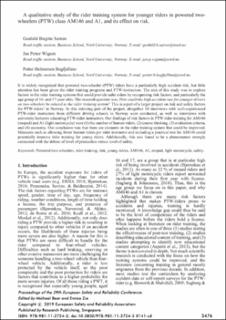| dc.contributor.author | Sætren, Gunhild Birgitte | |
| dc.contributor.author | Wigum, Jan Petter | |
| dc.contributor.author | Bogfjellmo, Petter Helmersen | |
| dc.date.accessioned | 2020-07-31T11:04:41Z | |
| dc.date.available | 2020-07-31T11:04:41Z | |
| dc.date.created | 2019-09-27T20:33:56Z | |
| dc.date.issued | 2019 | |
| dc.identifier.citation | Sætren, G. B., Wigum, J. P. & Bogfjellmo, P. H. (2019). A qualitative study of the rider training system for younger riders in powered two-wheelers (PTW) class AM146 and A1, and its effect on risk. In M. Beer & E. Zio (Eds.), Proceedings of the 29th European Safety and Reliability Conference (ESREL) (p. 3476-3483). Hannover: Germany. doi: | en_US |
| dc.identifier.isbn | 978-981-11-2724-3 | |
| dc.identifier.uri | https://hdl.handle.net/11250/2670568 | |
| dc.description.abstract | It is widely recognized that powered two-wheeler (PTW) riders have a particularly high accident risk, but little attention has been given the rider training programs and PTW-instructors. The aim of this study was to explore factors in the rider training systems that could provide safer riders by recognizing risk factors, and particularly the age group of 16- and 17-year-olds. The research question was; How could the high accident rate for younger drivers on two-wheelers be related to the rider training system? This is a part of a larger project on risk and safety factors for PTW-riders’ in Norway. In this initiating part of the project, altogether 10 interviews with well-experienced PTW-rider instructors from different driving schools in Norway were conducted, as well as interviews with university lecturers educating PTW-rider instructors. Our findings of risk factors in PTW rider training for AM146 (moped) and A1 (light motorcycle) were (1) the number of learner riders, (2) course thinking, (3) evaluation criteria, and (4) economy. Our conclusion was that there are elements in the rider training system that could be improved. Measures such as allowing fewer learner riders per rider instructor and including a practical test for AM146 could potentially improve rider training for young riders. Additionally, this was found to be a phenomenon strongly connected with the debate of level of production versus level of safety. Keywords: Powered two-wheelers, rider training, risk, young riders, AM146, A1, moped, light motorcycle, safety. | en_US |
| dc.language.iso | eng | en_US |
| dc.relation.ispartof | Proceedings of the 29th European Safety and Reliability Conference(ESREL). 22 – 26 September 2019 Hannover, Germany | |
| dc.relation.ispartofseries | Proceedings of the 29th European Safety and Reliability Conference(ESREL). 22 – 26 September 2019 Hannover, Germany | |
| dc.title | A qualitative study of the rider training system for younger riders in powered two-wheelers (PTW) class AM146 and A1, and its effect on risk | en_US |
| dc.type | Chapter | en_US |
| dc.type | Peer reviewed | en_US |
| dc.description.version | publishedVersion | en_US |
| dc.subject.nsi | VDP::Teknologi: 500 | en_US |
| dc.subject.nsi | VDP::Samfunnsvitenskap: 200::Pedagogiske fag: 280 | en_US |
| dc.subject.nsi | VDP::Samfunnsvitenskap: 200::Psykologi: 260 | en_US |
| dc.identifier.doi | 10.3850/978-981-11-2724-3_0141-cd | |
| dc.identifier.cristin | 1730519 | |
| dc.relation.project | The Research Council of Norway: 260524 | en_US |
